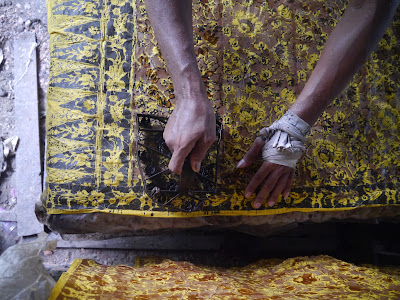The Story Begins
FEELING the cool, silky soft sand under my feet and listening to the waves caressing the shore gently, I strolled barefoot on Seberang Takir beach. How on earth did I get here? I quietly reflected on our journey so far.
It was a Friday, at dawn, just before sunrise. The hushed fishermen’s village behind me was slowly lumbering up to life. The vast South China Sea before me was calm and peaceful. A little wispy wind blew from the ocean, toyed with my hair, lifting it away.
HAND-BLOCKED HERITAGE
When I was growing up, my mother used to work in the duty-free industry. To keep us out of trouble, she made us work during the school holidays. It was then that I started forming my interest in aesthetics and retail.
I developed my appreciation for Malaysian heritage when I was studying abroad. When I returned for summer holidays, I would hunt for hand-blocked batik mostly, as well as kain tenun and songket.
It delighted me when I found a website sharing the stories of Kuala Terengganu hand-blocked batik makers, cataloguing their designs. I fell for Wan Azhar’s exquisite hand-blocked batik sarungs in pastel hues. Through the online compendium, I realised that I own quite a few designs by Wan Azhar batik.
Alas, only after a few years the reference site went offline. There was never a contact published, so I never knew the author. I have always been curious to learn more about our hand-blocked batik heritage. Without the website, the calling gradually grew louder.
Three years ago, my brother-in-law spent a lot of time in Kerteh, Terengganu. During one of his trips, my mum, my sister and I made a short journey to the East Coast. I made it a mission to go to Kuala Terengganu to search for Wan Azhar’s batik workshop.
PASAR PAYANG
The most logical place to go to in Kuala Terengganu to find a hand-blocked batik is Pasar Payang, the central market by Terengganu river, which is over 100years old. I was rather disappointed when we first stepped into Pasar Payang. The retailers lumped Kuala Terengganu hand-blocked batik with imported, imitation hand-blocked batik, as well as silkscreen or digitally printed “batik”, and declared them all Kuala Terengganu hand-blocked batik.
You need to know how to differentiate Kuala Terengganu hand-block batik to shop in Pasar Payang. From shop to shop, we asked for Wan Azhar batik.
We were fortunate enough to meet a songket retailer who knew the late Wan Azhar. He revealed that Wan Azhar was once the king of Pasar Payang. People from far and wide would come to Pasar Payang to mostly ask for Wan Azhar batik.
Unfortunately, he died in his sleep; his children were still in their teens then. Wan Azhar batik has never been quite the same since, he stressed. That piqued my curiosity. He then sent us looking in the old wing of Pasar Payang for authentic Kuala Terengganu hand-blocked batik.
Pakcik Wan Mokhtar of Haji Mohamed Abd Rahman at PPA 48, Pasar Payang stood out; the only retailer still carrying the full range of Kuala Terengganu hand-blocked batik.
We chat at his table about Kuala Terengganu batik. I shared with him the list of batik makers from the website, to my disappointment he said many of them have moved on to other things that provide better income.
I glanced at the far corner of his table, and saw a name card with a familiar look, I asked him whose it was. He explained that it belonged to a woman who used to come to Kuala Terengganu once a year to buy batik but had stopped coming, and then he handed the name card to me. My heart jumped out of its cage, I instantly recognised the domain name on the name card. There was a name. And a Portland address.
This was a huge accomplishment. Finally, uncovering the author behind the defunct site and the location of Wan Azhar’s workshop. I entertained the giddy excitement in my tummy.
SEBERANG TAKIR
As the sun beat down into midday, we took a motor-penambang from the city side. The engine chugged lazily in a rhythmic, hypnotic tempo. We went discreetly bobbing up and down across the river Terengganu, leaving V-shaped ripples stretching behind us.
Fishing boats painted in cheerful colours lined up along Seberang Takir river bank, they made for a welcoming sight for visitors. Sparse coconut palms were like thin legs dancing in the wind, inviting. Surrounding trees joined in, swaying to the rhythm.
My excitement heightened as the penambang inched closer to dock. We were first greeted by a keropok lekor kitchen, I dare say one of the few makers still offering a generous portion of fish paste in their fish sausage mix. As we walked further down Hujung Tanjung, Seberang Takir, we finally saw a big workshop with a signage that had read “Batik”.
Instinctively I knew that it was Wan Azhar’s batik workshop. We gave our salam to the house opposite the workshop. Peering out the window, Fidah, the late Wan Azhar’s youngest daughter, answered. Initially shy and reserved, Fidah started opening up to us after we showed interest in her late father’s work and story.
We learnt that at the height of the industry, Wan Azhar had 30 artisans working at his workshop. Alas, today they are left with two. Fidah related to us the state of the once flourishing industry today. Before leaving, we asked for her permission to have a look at their workshop. We were pointed to a much smaller workshop next to the house, the bigger workshop now abandoned.
My heart sank lower than I thought it could as we walked away. Little did I know that our day trip was the beginning to what would be an exciting and beautiful adventure.
Story published in NSTP March 1, 2017.



Comments
Post a Comment